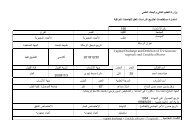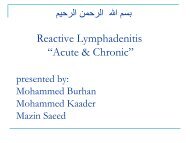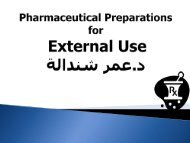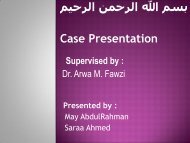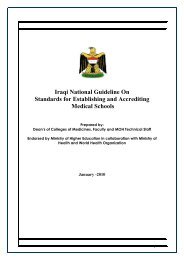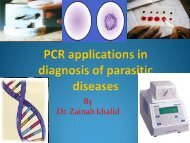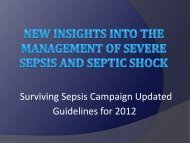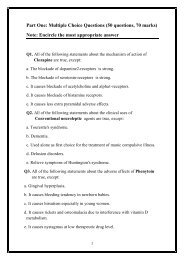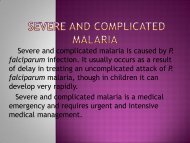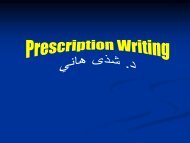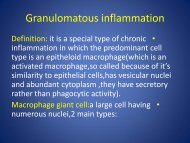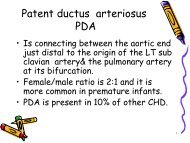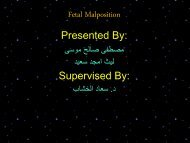Cholinergics and Anticholinergics
Cholinergics and Anticholinergics
Cholinergics and Anticholinergics
Create successful ePaper yourself
Turn your PDF publications into a flip-book with our unique Google optimized e-Paper software.
Nervous System Divisions<br />
AFFERENT<br />
EFFERENT
Objectives:<br />
To discuss the physiology of parasympathetic system<br />
To discuss the parasympathomimetic drugs both synthetic & natural<br />
,direct <strong>and</strong> indirect.<br />
To discuss anticholinergic drugs both antimuscarinic <strong>and</strong> antinicotinic.
Parasympathetic Responses
Direct acting<br />
Indirect acting (anticholinestrases)<br />
Cholinesters<br />
Nicotin<br />
alkaloids<br />
Short acting edrophonium<br />
Intermediate <strong>and</strong> long<br />
Acting carbamates<br />
cholinomimetic drugs<br />
(physiostigmine,neostigmine)<br />
Very long acting<br />
Organophosphate<br />
Echothiophate
Note:Nicotine acts to stimulate dopamine<br />
release in mesolimbic dopamine pathway<br />
(reward center).
Of these agents :<br />
Physostigmine:<br />
*is an alkaloid from the seeds of the plant physostigma<br />
*it is used synergistically with pilocarpine to decrease I.O.P also used<br />
in Alzheimer dementia. Dose: tab. 15mg inj. 2.5mg, is the<br />
maintenance drug of choice for patients with Myasthenia gravis.<br />
Slow release.<br />
Neostigmine:<br />
*t1/2 2h<br />
*it is synthetic reversible cholinesterase inhibitor.<br />
*its action is more prominent on the N-m junction <strong>and</strong> GIT than on<br />
C.V.S <strong>and</strong> eye. That is why its main use is in the management of<br />
myasthenia gravis <strong>and</strong> to stimulate the bowels <strong>and</strong> bladder after<br />
surgery <strong>and</strong> as antidote to competitive N-m blocking agents. oral<br />
dose 5-30 mg 3-4 times a daily. S.c 0.5-2 mg(Poorly absorbed<br />
orally so requires larger doses than when given parenterally.<br />
Often combined with atropine to reduce the unwanted muscarinic<br />
effects.
Pyridostigmine:<br />
*is similar to Neostigmine but of less effect <strong>and</strong> slower onset <strong>and</strong><br />
slightly longer duration of action. The only anticholinesterase<br />
capable of crossing the blood brain barrier. Is more lipid soluble.<br />
Used as an antidote for overdosage of anticholinergics such as:<br />
atropine, antihistamines, TCA, phenothiazines.<br />
*used in the treatment of myasthenia gravis.<br />
Edrophonium:<br />
*is structurally related to Neostigmine but its action is brief .<br />
*it is used to diagnose myasthenia gravis <strong>and</strong> to differentiate a<br />
myasthenia crisis (weakness due to inadequate anticholinestrase<br />
treatment or sever disease) from a cholinergic crisis (weakness<br />
caused by over treatment with anticholinestrase).<br />
*the actions of 3mg I.V are lost in 5 min.<br />
Metriphonate :<br />
Is used for urinary schistosomiasis.
Indirect Acting Agents used to treat<br />
Alzheimer’s disease<br />
Donepezil (Aricept)—said to delay<br />
progression of the disease by up to 55<br />
weeks. Does not cause liver toxicity.<br />
Galantamine (Reminyl)—newest drug<br />
Rivastigmine (Exelon) long acting. Twice a<br />
day dosing.<br />
Tacrine (Cognex)—hepatoxic. Elevated<br />
liver enzymes usu. Within 18 wks. > in<br />
women.
Toxicity of Irreversible<br />
Anticholinesterase Agents<br />
These agents are lipid soluble<br />
Can enter the body by the eye,skin,<br />
respiratory system <strong>and</strong> GI tract.<br />
Case in point, organophosphate<br />
insecticides (malathion, parathion) or<br />
nerve gases (sarin, tabun, soman)<br />
These agents cause excessive<br />
cholinergic stimulation (muscarinic) <strong>and</strong><br />
neuromuscular blockade
Pesticides of the carbamate type act by reversible inhibition of<br />
cholinestrase where as organophosphorus compounds inhibit the enzyme<br />
almost or completely irreversible (so recovery depends on the formation of<br />
new enzyme this process may take weeks, although clinical recovery is<br />
usually evident within days ). Of these substances GA (tabun), GB (sarin)<br />
<strong>and</strong> GD (soman) called nerve gas, although they are volatile liquids.<br />
Note: where there is known risk of exposure , prior use of<br />
pyridostigmine, which occupies cholinesterase reversibly for few<br />
hours, completely protect them from access.<br />
Note: organophosphate are absorbed through the skin, the GIT <strong>and</strong><br />
by inhalation.
Clinical manifestations<br />
Primary = easy fatigability of skeletal<br />
muscle during activity.<br />
Muscles involved: eyes <strong>and</strong> eyelids,<br />
chewing, swallowing, speaking, <strong>and</strong><br />
breathing.<br />
Fluctuating weakness: usually strong in<br />
the morning, progressively weaker with<br />
activity.
Clinical manifestations<br />
Variable course<br />
<br />
May be precipitated by emotional stress,<br />
pregnancy, menses, secondary illness,<br />
trauma, temperature extremes,<br />
hypokalemia, ingestion of drugs with<br />
neuromuscular blocking agents, surgery.
Specific Conditions—Cholinergic vs.<br />
Myasthenic Crisis<br />
Myasthenic crisis requires more<br />
anticholinesterase drug whereas<br />
cholinergic crisis requires discontinuation<br />
of the anticholinesterase drugs<br />
Diagnosis can be made by evaluating<br />
patient patient response to their medication<br />
(s/s one hour after medication often is<br />
cholinergic crisis, s/s 3 or more hours after<br />
medication often is myasthenic crisis
Atropine<br />
Atropine is an alkaloid found in atropa<br />
belladona<br />
<br />
It is a competitive antagonist for the<br />
muscarinic acetylcholine receptor<br />
<br />
Because it’s a tertiary amine atropine is<br />
relatively lipid soluble <strong>and</strong> cross BBB<br />
<strong>and</strong> it’s well distributed through the CNS<br />
<br />
30
Atropine<br />
continue<br />
Duration of action is 4 to 8 hours except<br />
in the eyes where it reaches 72 hours or<br />
longer<br />
initial single doses in adults vary from<br />
around 0.5 mg to 1 mg<br />
40% metabolized in the liver,60%<br />
excreted un changed in the urine<br />
•<br />
•<br />
•<br />
31
Pharmacological Actions…<br />
Drugs<br />
Duration of Effect in<br />
eye (Days)<br />
Usual Concentration (%)<br />
Atropine 7-10 0.5-1<br />
Hyoscine 3-7 0.25<br />
Homatropine 1-3 2-5<br />
Cyclopentolate 1 0.5-2<br />
Tropicamide 0.25 0.5-1
CHOLINOCEPTOR-BLOCKING DRUGS<br />
MUSCARINIC ANTAGONISTS<br />
ORGAN<br />
CNS<br />
EYE<br />
HEART<br />
RESPIRATORY<br />
GIT<br />
GUT<br />
GLANDS<br />
SKELETAL<br />
MUSCLES<br />
EFFECTS<br />
Sedation, hallucination, drowsiness, antimotion sickness action,<br />
antiparkinson action, amnesia<br />
Mydriasis, cyclopegia, lacrimal gl<strong>and</strong>s become dry <strong>and</strong> s<strong>and</strong>y<br />
Initial bradycardia at low doses then tachycardia<br />
Bronchodilation, decrease in bronchial secretions<br />
Relaxation, decrease motility, antidiarrheal, prolongs gastric<br />
emptying time<br />
Relaxation of the bladder wall, urinary retention<br />
Decrease secretion, salivation, lacrimation, sweating<br />
None
Features:<br />
1. Dry mouth with dysphasia.<br />
2. Mydriasis, blurred vision.<br />
3. Hot flushes , dry skin with hyperthermia (CNS effect + absence of<br />
sweating).<br />
4. Restlessness ,anxiety, excitement ,hallucinations, delirium, mania.<br />
The cerebral excitation is followed by depression <strong>and</strong> coma.<br />
Treatment:<br />
by giving activated charcoal to adsorb the drug, diazepam for excitement .<br />
cooling agents (ice bags, cooling blankets, tepid baths). In severe cases<br />
usePhysostigmine:<br />
Antidote<br />
Abolishes delirium & coma<br />
Dose:<br />
I/V – Adults: 1-4 mg<br />
Children: 0.5-1 mg
Parkinson’s Disease<br />
Useful in those with minimal side effects<br />
Those who cannot take Levodopa<br />
Helpful in decreasing salivation,<br />
spasticity <strong>and</strong> tremors<br />
Benzhexol <strong>and</strong> orphendrine, used<br />
in the treatment of parkinsonism
Preop<br />
Help prevent vagal stimulation <strong>and</strong><br />
potential bradycardia<br />
Reduce respiratory secretions as well<br />
Produce amnesia
1.For their action on CNS:<br />
a. Benzhexol ,orpheradrine, against rigidity <strong>and</strong> tremor in<br />
parkinsonism<br />
b. promethazine, as antiemetic.<br />
c. Hyoscine to prevent or reduce motion sickness.<br />
d. Hyoscine sedative action , so used in anesthetic premedication.<br />
2.For there peripheral effects:<br />
a. atropine, homatropine, <strong>and</strong> cyclopentolate used to dilate the<br />
pupils <strong>and</strong> paralyze ocular accommodation. If it is desired to<br />
dilate the pupil <strong>and</strong> to spare accommodation, a sympathomimetic<br />
e.g. phenylphrine is used.<br />
b. In the respiratory tract, ipratropium is an effective bronchodilator.
Respiratory<br />
In bronchospasm whether related to<br />
asthma or COPD<br />
Atrovent very useful for its bronchodilating<br />
effects<br />
Ipratropium:is used by inhalation as<br />
bronchodilator <strong>and</strong> can be useful when cough<br />
is a pronounced symptom in an asthmatic<br />
patient. Dose 0.4-2ml of a 0.02% solution up to<br />
4.t.d. Aerosol 1-2 puffs 3-4 t.d.<br />
Nebulizer solution 250 microgram/ml.
<strong>Anticholinergics</strong><br />
in asthma<br />
•Ipratropium<br />
•Tiotropium<br />
Primarily, the site of bronchodilation action of inhaled β 2 -adrenergic<br />
agonists is mainly the bronchiolar smooth muscle. Atropinic drugs<br />
cause bronchodilation by blocking cholinergic constrictor tone,<br />
act primarily in large airways.
Homatropine<br />
Tropicamide
3. For actions on GIT:<br />
dicyclomine, hyoscine butylbromide used against spasm of m. <strong>and</strong><br />
hypermotility.<br />
4.In the urinary tract:<br />
Flavoxate, propantheline <strong>and</strong> oxybutynin, are used to relieve m-spasm<br />
accompanying infection in cystitis <strong>and</strong> for detrusor instability.<br />
5. C.V.S:<br />
atropine is useful in bradycardia following M.I.<br />
6. Cholinergic poisoning:<br />
Atropine is an important antagonist of both central nervous<br />
parasympathominetic <strong>and</strong> vasodilator effects. Its also used to block<br />
muscarinic effects when cholinergic drugs such a Neostigmine are<br />
used for their effect on the N-m junction in MG.
Contraindications<br />
BPH<br />
Myasthenia gravis<br />
Hyperthyroidism<br />
Glaucoma<br />
Tachydysrhythmias<br />
Not in situations whereby delaying of<br />
gastric emptying is a concern
Nicotinic antagonists<br />
a. Ganglion blocking agents<br />
hexamethionin, mecamylamine <strong>and</strong> other ganglion-blocker<br />
were extensively used in the treatment of hypertension ,but<br />
unfortunately , the adverse effect of ganglion blocked are<br />
so sever (both sympathetic <strong>and</strong> parasympathetic divisions<br />
are blocked), that patients are unable to tolerate long term<br />
treatment with them.Duration of action is about 10 h after a<br />
single administration<br />
Trimethaphan is the only Ganglion-blocker still in clinical use<br />
its poorly lipid soluble inactive orally <strong>and</strong> has a short halflife<br />
it is used I.V to treat sever accelerated hypertension<br />
(malignant hypertension) <strong>and</strong> to produce controlled<br />
hypotension.
GANGLION-BLOCKING DRUGS<br />
Hexamethonium <br />
Trimetaphan<br />
Tubocurarine<br />
Pancuronium<br />
Atracurium<br />
Vecuronium
Effector site<br />
Predominant<br />
tone<br />
Effect of ganglionic Blockade (side effects)<br />
Arterioles Sympathetic Vasodilation, Hypotension<br />
Veins Sympathetic Dilation (Postural Hypotension)<br />
Heart (SA node) Parasympathetic Tachycardia (palpitation)<br />
Eye<br />
•Iris<br />
•Ciliary Muscle<br />
Parasympathetic<br />
Parasympathetic<br />
Mydriasis (photophobia)<br />
Cycloplegia (blurred vision)<br />
Git Parasympathetic Reduced tone & motility, decreased secretions<br />
Urinary bladder Parasympathetic Decreased tone (constipation), detrusor muscle<br />
relaxation<br />
Male genital organs<br />
•Vascular vessel<br />
•Vas deferens<br />
Parasympathetic<br />
Sympathetic<br />
Failure to erection (impotence)<br />
Failure to ejaculate (impotence)<br />
Lacrimal gl<strong>and</strong>s Parasympathetic Reduced lacrimation (dry s<strong>and</strong>y eyes)<br />
Salivary gl<strong>and</strong>s Parasympathetic Reduced salivation (dryness of mouth)<br />
Sweat gl<strong>and</strong>s Sympathetic Reduced sweating (anhydrosis)
Ganglion blockers<br />
Effector<br />
organs<br />
Arterioles/<br />
veins<br />
Dominant<br />
system<br />
SANS<br />
Effects of ganglionic<br />
blockade<br />
Sweat gl<strong>and</strong>s SANS Anhydrosis<br />
Genitals<br />
PANS/SAN<br />
S<br />
Vasodilatation, hypotension<br />
Impotence<br />
Heart PANS Tachycardia<br />
Iris PANS Mydriasis<br />
Ciliary PANS Cycloplegia<br />
Bladder PANS Urinary retention<br />
Salivary PANS Xerostomia<br />
GIT PANS Constipation.
Note:<br />
As ganglion-blocking agents interrupts sympathetic control of<br />
venous-pooling, postural hypotension.<br />
these drugs are important for producing complete sk-m<br />
relaxation in surgery by specific blockade of the N-M junction.<br />
They enable light level of anesthesia to be employed with<br />
adequate relaxation of the muscles of the abdomen <strong>and</strong><br />
diaphragm ,they also relax the vocal cords <strong>and</strong> allow the<br />
passage of a tracheal tube .patients who have received a m-<br />
relaxant Should always have their respiration assisted or<br />
controlled until the drug have been inactivated or antagonized.
Glaucoma
Glaucoma<br />
Glaucoma is increased intraocular <br />
pressure.<br />
Intraocular pressure is determined by the<br />
balance between fluid input & drainage out<br />
of the globe<br />
----- aqueous humor produced by ciliary<br />
epithelium <strong>and</strong> drained at the filtration<br />
angle of the anterior chamber.<br />
Objective of glaucoma therapy : ---<br />
increase outflow & or decrease<br />
production of aqueous humor.




